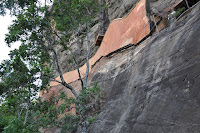The aerial view of the Sigiriya gardens was fabulous, though we had not yet reached the summit. According to experts they reflect the art and architecture of the 5th century Sri Lankan engineers with the designing of symmetric and asymmetric structures , which have been admired since then.

I had honestly thought the climb up to the Lion's terrace would be harder but the steps were wide enough not to pose too many difficulties.
Only the rock carving and the brick structure of the Lion's mouth, which used to be the entrance to the palace survived but despite the fact that the mouth of the lion crumbled one can easily imagine what it might have been like.
The hardest was still to come as we climbed up to the summit, and though quite a few people stayed at the Lion's terrace I felt it would be a pity to have reached this height and not make an additional effort to climb further ... and so I did (and was fairly proud of having "overcome" my fear ..., particularly because it was worth the effort, despite the fact that the Royal pavillion was mostly reduced to ruins).
According to written reports there is evidence of a rather elaborate and sophisticated water system from the foot of Sigigiya to the summit still astonishing hydrologists which continue to theorise on the accomplishements of the early engineers.
The climb down provided a different perspective, as we came across the mirror wall and several rock and man-made shelters using brick walls and large boulders as roofs (after Kassapa's defeat the Lion Rock is said to have been "handed back" to the monks), as well as other rock formations, caves (the Cobra hood cave) and 6th century rock painting remains.




Having noticed warning signals mentioning hornets and wasps and how to react in case of an attack, made us almost instantaneously smile, as if it were possible for anyone to keep still and silent under such circumstances ..., once the simple sight of "something" as small as a cameleon moving in the rocks made us almost cry out for help ...

It was soon time for lunch and I don't know whether it was the climb or the prospect of still having a long way towards Kandy ... but I felt I was desperately in need of having something to eat ...























































